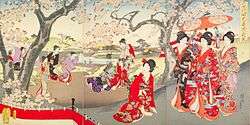Ōoku


The Ōoku (大奥 great interior) refers to the harem of Edo Castle, the section where the women connected to the reigning Shogun resided. Similar areas in the castles of powerful Daimyo were also referred to by this term.[1]
This included the shōgun's mother, wife, and concubines. Rumored to house several thousand women, including maids and servants at one point, the Ōoku was, as much as any other part of Edo Castle, a focal point of political intrigue for the Tokugawa shogunate.
There were no male adults admitted onto the floor of the Ōoku without the Shōgun. The corridor through which the Shōgun entered was called Osuzu Rōka (御鈴廊下) "passage of the bells", derived from the ringing of the bells to announce the entrance of the Shōgun. This corridor was the only route which connected the Ōoku to rest of Edo Castle, and it was usually locked.
Later, a second corridor was built as the escape route against disasters such as fires or earthquakes.
A lady in the rank of an Otoshiyori (御年寄) or Jōrō Otoshiyori (上臈御年寄) held the reins of power in the Ōoku, and she attained the influence equivalent to a Rōjū in Edo Castle.
The Ōoku was built inside the Edo Castle in 1607 by Tokugawa Hidetada. He passed a special law for the Ōoku to completely separate it from the outside world. Therefore, noblewomen living in the Ōoku couldn't leave the castle without permission. This system lasted for nearly 200 years.
In popular culture
There are many popular portrayals of the Ōoku.[2] Recent ones include the Japanese television drama Ōoku: Hana no Ran, Atsuhime (NHK Taiga drama), Oh! Oku (2006 film), Ōoku: The Inner Chambers (Japanese manga), Masami Okui best album: Ōoku (2008) and Ōoku (2010 film).
Notes
External links
 The dictionary definition of ōoku at Wiktionary
The dictionary definition of ōoku at Wiktionary
Coordinates: 35°41′18″N 139°45′16″E / 35.688324°N 139.754389°E
|